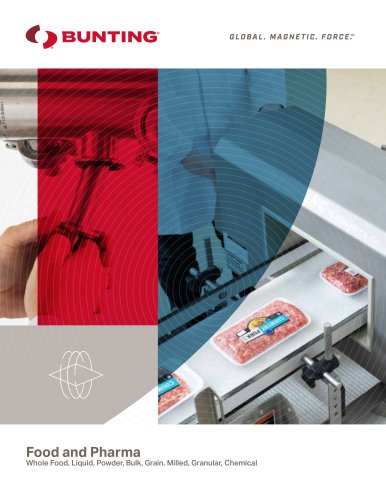
Catalog excerpts

Custom Magnets and Magnet Assemblies
Open the catalog to page 1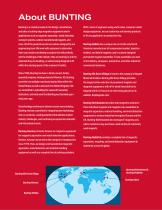
About BUNTING Bunting is an industry leader in the design, manufacture, With a team of engineers using world-class, computer-aided and sales of cutting-edge magnetic equipment used in design equipment, we can customize and develop products applications such as magnetic separation, metal detection, to fit any application or production line. conveyor systems, custom manufactured magnets, and more. All of the products we sell are custom-designed by our Bunting-DuBois has a unique role as it is the only North engineering team. We work with customers to determine American manufacturer of...
Open the catalog to page 2
Bunting ® Magnetic Technology for All Industries Separation, Detection, and Conveying Equipment for the Recycling Industries The unique benefits of magnetic technology can be utilized across a wide range of applications, and Bunting is always looking to the future regarding new challenges that present themselves in the many industries we work with. Bunting engineers are constantly working to develop new technologies and improve upon our existing product lines. Bunting custom designs, manufactures, and distributes a broad selection of magnets and magnetic assemblies for automotive, medical,...
Open the catalog to page 3
Permanent Magnets: Alnico Magnets Permanent magnets are essential to virtually Alnico magnets are alloys comprised of aluminum, convenience. Being able to provide the optimum operating temperature and temperature stability every type of modern technology and magnetic solution to the customer requires in-depth knowledge of the full supply chain. Bunting’s team of magnet experts and engineers is fully equipped with this knowledge. Bunting entered the magnetics industry in 1959 as a magnet distributor and rapidly grew to a manufacturer of magnetic products, focused on custom design and...
Open the catalog to page 5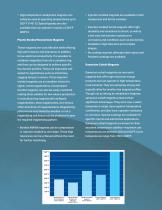
• High-temperature neodymium magnets can safely be used at operating temperatures up to 300° F (149° C). Special grades are also available that can operate in excess of 392°F (200°C). • Injection molded magnets are available in both neodymium and ferrite varieties. • Injection molded ferrite magnets offer high durability and resistance to shock, as well as a low cost and extreme resistance to corrosions and conditions such as low density. Plastic Bonded Neodymium Magnets These magnets are-cost effective while offering high performance and tolerances in addition to low electrical...
Open the catalog to page 6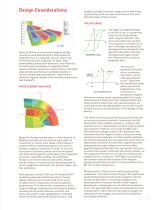
Design Considerations length of design contract ranges from a few hours to many days and we pride ourselves on the cost effectiveness of this service. THE BH CURVE: The basis of magnet design B is the BH curve, or hysteresis Br loop, which characterizes each magnet material. This load line curve describes the cycling at BHmax H of a magnet in a closed circuit as it is brought to saturation, demagnetized, saturated in the H opposite direction, and then Hc demagnetized again under the influence of an external magnetic field. The Demagne Basic problems of permanent magnet design revolve around...
Open the catalog to page 7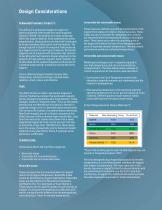
Design Considerations PERMANENT MAGNET STABILITY: Irreversible but recoverable losses: The ability of a permanent magnet to support an external magnetic field results from small magnetic domains “locked” into position by crystal anisotropy within the magnet material. Once established by initial magnetization, these positions are held until acted upon by forces exceeding those which lock the domains. The energy required to disturb the magnetic field produced by a magnet varies for each type of material. Permanent magnets can be produced with extremely high coercive forces (Hc) which will...
Open the catalog to page 8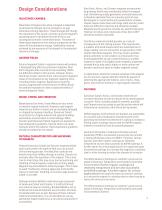
Design Considerations RELUCTANCE CHANGES: Reluctance changes occur when a magnet is subjected to permeance changes such as changes in air gap dimensions during operation. These changes will change the reluctance of the circuit, and may cause the magnet’s operating point to fall below the knee of the curve, causing partial and/or irreversible losses. The extent of these losses depends on the material properties and the extent of the permeance change. Stabilization may be achieved by pre-exposure of the magnet to the expected reluctance changes. ADVERSE FIELDS: External magnetic fields in...
Open the catalog to page 9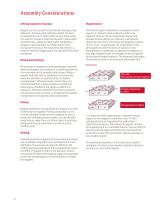
Assembly Considerations Affixing magnets to housings: Magnets can be successfully affixed to housings using adhesives. Cyanoacrylate adhesives which are rated to temperatures up to 180 C with fast cure times avoid the need for fixtures to hold the magnets in place while the bond cures. Adhesives with higher temperature ratings are also available, but these require oven curing and fixturing of the magnets to hold them in a vacuum. Potential outgassing of the adhesives should be considered. Permanent magnet materials are composed of small regions or “domains” each of which exhibit a net...
Open the catalog to page 10
In general, permanent magnets are supplied with a simple 2 pole magnetization pattern: a North pole on one face and a South pole on the opposite face. However, by appropriate configuration of the magnetizing coils it is possible to construct a fixture that will magnetize a magnet with many pole-pairs, and for some materials, pole patterns on a single surface of the magnet. This is called multi-pole magnetization. Magnetizing Patterns Radial Through Arc Segment Prototype Magnetizing Fixtures/Tooling: For development projects, prototype fixtures can be built quickly after design. These allow...
Open the catalog to page 11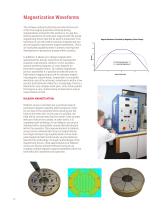
Magnetization Waveforms The software utilized by Bunting can take full account of the true magnet properties achieved during magnetization and predict the surface or air-gap flux density waveforms of multi-pole magnets with the actual magnetizing fixture that will be used in production. This technique is not restricted to isotropic magnets and can also be applied to permanent magnet assemblies. This is an invaluable capability when it comes to moving from development to production phases within a project. In addition, it allows us to design magnets with specialized flux density wave forms...
Open the catalog to page 12All Bunting-Newton catalogs and technical brochures
-
Printing
24 Pages
-
Recycling
44 Pages
-
Metal Working & Fabricating
24 Pages
-
Aggregate,Mining,and Minerals
20 Pages
-
Magslide
3 Pages
-
FF Series
5 Pages
-
Plastics Industry
56 Pages
-
Food and Pharma Industries
52 Pages









